Comments / Questions (33)
![]() Aline wrote:
Aline wrote:
Guten Abend, gibt es ein Tutorial speziell für diese Mütze vom Verkürzen, Wenden und Überstricken? Bei der Höhendifferenz von 5 cm bis zum Überstricken bekomme ich leider doch Löcher. Oder überstricke ich doch schon früher und habe einen Denkfehler? Gibt es Fotos von der Rückseite? Lg
26.11.2024 - 23:42
![]() Mona Lill Paulsen wrote:
Mona Lill Paulsen wrote:
164-7 Snur jeg etter 10 masker, eller snur jeg på 10 maske? Syr vi sammen på rangen eller retten, savner bilde av baksiden av lua….
16.09.2024 - 11:19DROPS Design answered:
Hei Mona. Du snur pår det gjenstår 10 masker (på venstre pinne). Altså, du har 67 masker på pinnen, strikk riller og glattstrikk over 57 masker, du har 10 masker på venstre pinne, snu arbeidet, og strikk til det gjenstår 10 masker på høyre pinne, snu arbeidet. Strikk videre som forklart i oppskriften. Ved sammensying, ta en titt på videoen: Hvordan montere med usynlig maskesting. mvh DROPS Design
19.09.2024 - 08:34
![]() Marga Flaßwinkel wrote:
Marga Flaßwinkel wrote:
Eine sehr schöne Mütze, die ich gern stricken würde. Warum gibt es keine Angabe zur Maschenprobe, vor allem aber keine Maße in cm und keine graphische Abbildung?
10.04.2023 - 14:43DROPS Design answered:
Liebe Frau Flaßwinkel, Maschenprobe finden Sie unter die Kopfzeilen, zusammen mit den Größen, Garn, Garnmenge, Nadel usw... Skizze gibt es dazu keine, nur Diagram für das 2-Fädig Muster. Viel Spaß beim stricken!
11.04.2023 - 14:15
![]() Giliane wrote:
Giliane wrote:
Bonjour, N’étant pas douée pour tricoter en jacquard, Je souhaite le faire en uni. Combien de pelotes dois-je utiliser ? Cordialement, Giliane
12.12.2022 - 20:51DROPS Design answered:
Bonjour Giliane, comme ce modèle a été tricoté en jacquard, nous avons seulement cette quantité et n'avons plus le modèle pour le peser. Vous pouvez ajouter toutes les couleurs ensemble, il vous en faudra probablement un peu moins. Votre magasin DROPS saura vous aider et vous conseiller, même par mail ou téléphone. Bon tricot!
13.12.2022 - 08:04
![]() Maria wrote:
Maria wrote:
Per realizzare il cappello non è necessario usare i ferri circolari. Giusto? Non si vede il dietro del cappello. immagino che al centro del dietro si formi una motivo a legaccio di 6 maglie giusto?
06.10.2022 - 06:56DROPS Design answered:
Buonasera Maria, è corretto, non deve usare i ferri circolari e ci sono 3 maglie a legaccio a ogni lato. Buon lavoro!
07.10.2022 - 20:59
![]() Beatriz wrote:
Beatriz wrote:
Bonjour, c'est-ce que j'ai fait 13mx17rx 2 fils BAS = en double (pour avoir 10cm), aiguilles 6,5,5,5 mais je n'arrive pas à avoir le bon résultat pour commencer à tricoter. j'ai changé les aiguilles de plus grandes à plus petites jusqu'à 4.5 et cela me donne toujours 7 cm sur 10 cm. quoi faire d'autre
27.11.2020 - 17:02DROPS Design answered:
Bonjour Beatriz, vous tricotez peut-être serré? Essayez de changer d'aiguilles - mais pas seulement la taille, également la matière si possible, ça joue parfois sur votre tension. Demandez conseil à votre magasin (même par mail ou téléphone), il aura peut-être des astuces pour vous. Bon tricot!
30.11.2020 - 07:51
![]() Beatriz wrote:
Beatriz wrote:
Bonjour, je n'arrive pas à faire un échantillon 2 mailles ensemble Brushed Alpaca Silk comme indiqué. J'ai pris des aiguilles plus petites et plus grandes et j'arrive au même résultat, cad. ça ne me donne que 7 mailles sur 10. quoi faire d'autre, j'ai hâte de commencer ce bonnet et je suis incapable de le faire, merci beaucoup si vous pouvez m'aider
27.11.2020 - 15:54DROPS Design answered:
Bonjour Beatriz, je ne suis pas sûre de comprendre, votre échantillon doit être de 13 m x 17rangs pour le bonnet avec 2 fils Brushed Alpaca Silk tricotés ensemble (= en double) - je ne comprends pas vos "2 mailles ensemble". Si vous n'avez pas le bon échantillon, vous ne pourrez obtenir les bonnes mesures. Bon tricot!
27.11.2020 - 16:17
![]() Coraline wrote:
Coraline wrote:
Bonjour , quand on fait les rangs raccourcis qu’est ce qu’on fait avec les mailles non tricotées de chaque côté ? Exemple les 10 mailles ou 5 mailles non tricoteées sont en attente sur l’aiguille .. elles ne sont pas encore rabattues . Merci de votre aide !
14.11.2019 - 15:31DROPS Design answered:
Bonjour Coraline, on laisse les mailles de chaque côté en attente jusqu'à la fin des rangs raccourcis, on les reprendra ensuite quand on va tricoter la côte mousse sur toutes les mailles avec l'aiguille 5,5. Bon tricot!
14.11.2019 - 15:50
![]() Kathryn wrote:
Kathryn wrote:
Hi, the pattern says to use a40cm circular needle or long enough to cast on 13st but then it says cast on 73st which will not fit on a 40cm needle, but 14st would. ???
21.10.2019 - 17:07DROPS Design answered:
Hi Kathryn, The 13 stitches mentioned after the needle size is for your knitting tension - so 13 stitches x 17 rows should give you 10 x 10 cm if your tension is right. If you find the length of the needle too short you could try 60 cm in length. Happy knitting!
22.10.2019 - 07:28
![]() Gwendoline HILLAIRET wrote:
Gwendoline HILLAIRET wrote:
Oui ça j\'avais compris mais le soucis quand on arrive a la fin des 15 mailles mais pour faire les mailles endroits ( point mousse) je me retrouve au milieu du travail et pas sur un côté du travail ?
13.12.2018 - 09:54DROPS Design answered:
Bonjour Mme Hillairet, tout à fait, à la fin des rangs raccourcis, vous êtes au milieu du rang, vous pouvez couper le fil, glisser toutes les mailles sur la même aiguille et tricoter 1 rang sur l'endroit sur toutes les mailles en augmentant 6 mailles à intervalles réguliers. Bon tricot!
13.12.2018 - 12:35
Sweet Winter Hat#sweetwinterhat |
|||||||||||||
 |
 |
||||||||||||
Set consists of: Knitted DROPS hat in 2 strands ”Brushed Alpaca Silk” or 1 strand ”Melody” with Nordic pattern, pompoms and garter band and neckwarmer with rib.
DROPS 164-7 |
|||||||||||||
|
KNITTING TIP: To avoid the knitting tension to tighten when working pattern, it is important not to tighten the strands on back side of piece. Switch to a higher needle no when working pattern if the pattern is somewhat tight. DOUBLE YARN TIP: Use yarn from both inside and outside of the ball. When switching to a new ball, try to avoid switching both strands at the same time - to avoid a thick yarn when fastening. GARTER ST (back and forth): K all rows. 1 ridge = 2 rows K. PATTERN: See diagram A.1. The diagrams show all rows in pattern seen from RS. Work all pattern sts in stocking st with 2 strands Brushed Alpaca Silk (= BAS) or 1 strand Melody (= M). DECREASE TIP: Dec 1 st by K 2 sts tog. ---------------------------------------------------------- HAT: Work back and forth on circular needle and sew tog mid back - READ DOUBLE YARN TIP and KNITTING TIP. NOTE: Work the 3 sts in garter st in each side always in base colour on every row in pattern. Cast on 73 sts with 2 strands grey Brushed Alpaca Silk or 1 strand grey Melody on circular needle size 5.5 mm. Work 3 ridges in GARTER ST back and forth - see explanation above, and dec on 5th row 6 sts evenly (but no over the outermost 3 sts in each side) - READ DECREASE TIP = 67 sts. Switch to circular needle size 6 mm and continue with PATTERN - see explanation above - as follows: Work 3 sts in garter st, work A.1 (= 12 sts) 5 times in width, work first st in A.1 so that pattern is symmetrical in each side, 3 sts in garter st. Continue like this back and forth. REMEMBER THE KNITTING TENSION When A.1 has been worked vertically, continue with grey ( 2 strands Brushed Alpaca Silk/ 1 strand Melody) until finished measurements. When piece measures 20 cm, work as follows: Work until 10 sts remain, turn and work until 10 sts remain, turn and work until 15 sts remain, turn and work until 15 sts remain. Continue like this by working 5 sts less on every row until piece measures 25 cm. Switch to circular needle size 5.5 mm. Work 1 ridge in garter st over all sts and inc on first row 6 sts evenly = 73 sts. Cast off. POMPOMS: Make 2 large pompoms with grey with an approx. diameter of 7 cm. Fasten a pompom in each end of cast-on edge. ASSEMBLY: Fold hat so that cast-off edge is placed double. Beg at the edge in each side and sew one and one st neatly tog towards the middle of cast-off edge. Cut the yarn and fasten. ---------------------------------------------------------- NECK WARMER: Worked in the round on circular needle. READ DOUBLE YARN TIP. Cast on 76-84 sts on circular needle size 5.5 mm with 2 strands Brushed Alpaca Silk or 1 strand Melody. Work rib = K 2/P 2 for 20-22 cm. REMEMBER THE KNITTING TENSION Cast off sts with K over K and P over P. |
|||||||||||||
Diagram explanations |
|||||||||||||
|
|||||||||||||
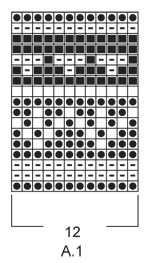
|
|||||||||||||
Have you finished this pattern?Tag your pictures with #dropspattern #sweetwinterhat or submit them to the #dropsfan gallery. Do you need help with this pattern?You'll find 24 tutorial videos, a Comments/Questions area and more by visiting the pattern on garnstudio.com. © 1982-2025 DROPS Design A/S. We reserve all rights. This document, including all its sub-sections, has copyrights. Read more about what you can do with our patterns at the bottom of each pattern on our site. |
|||||||||||||







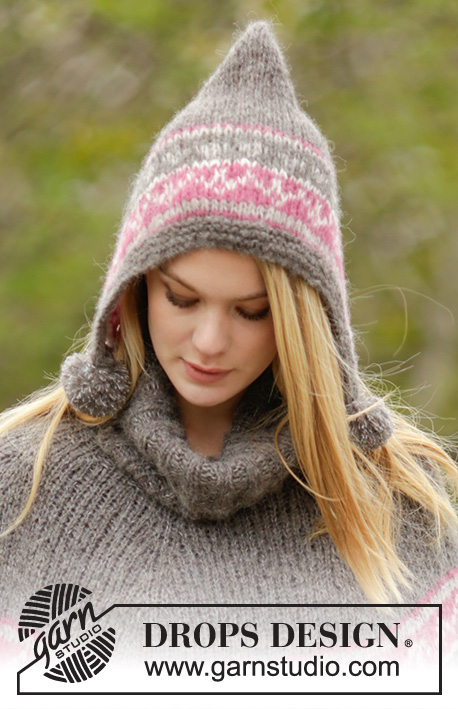

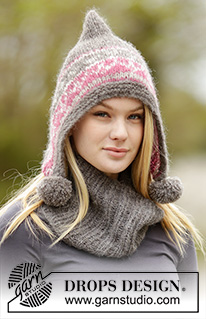
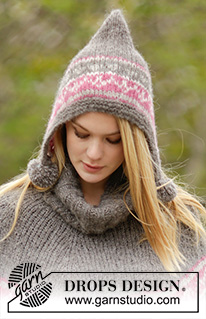







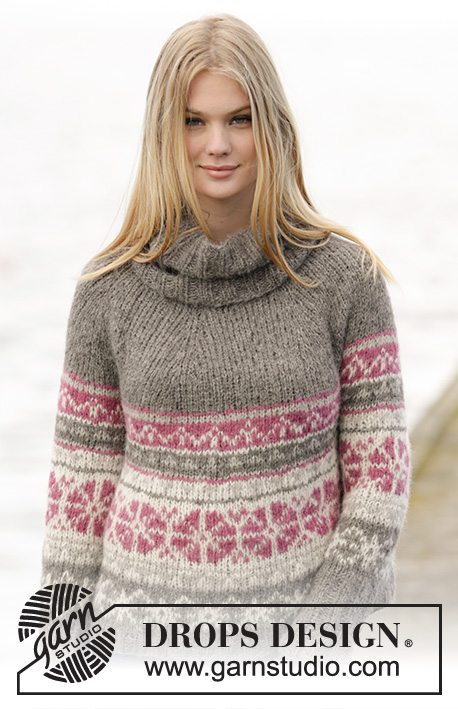














































Post a comment to pattern DROPS 164-7
We would love to hear what you have to say about this pattern!
If you want to leave a question, please make sure you select the correct category in the form below, to speed up the answering process. Required fields are marked *.